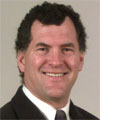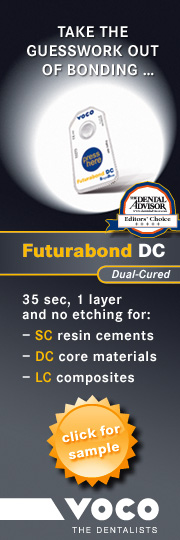| |
|
A member service that keeps you up-to-date on important new literature relevant to your practice.



|
|
JCDA has partnered with Dalhousie University's faculty of dentistry for this edition of JCDA Express. The Dalhousie faculty members answer some common clinical questions by accessing research articles from the scientific literature.
The topics covered are pseudocholinesterase deficiency, comparison of gingival grafts, dental emergencies in pregnant patients, esthetics with anterior crowns and postoperative bleeding with patients on warfarin and aspirin therapy.
JCDA is pleased to continue developing partnerships with Canada's dental faculties, to bring you the latest research pertinent to your clinical practice.
JCDA would like to gratefully acknowledge the publishers of the selected articles, who have granted free access to the full-text papers until April 18, 2011. Follow the links in the Notes and News sidebar to discover more about these publications.
Remember to follow JCDA.ca on Twitter to keep informed when new clinical and scientific material is posted to JCDA.ca. Please tweet or send me an email with topics you would like to see covered in future editions of JCDA Express.
Yours sincerely,
Dr. John P. O'Keefe
Editor-in-chief
jokeefe@cda-adc.ca
|
|


 |
|
|

Dr. Curtis Gregoire is an assistant professor in the department of oral and maxillofacial sciences at Dalhousie University's faculty of dentistry.
Clinical question: Can I use local anesthetic on a patient who has pseudocholinesterase deficiency?
Soliday FK, Conley YP, Henker R. Pseudocholinesterase deficiency: a comprehensive review of genetic, acquired, and drug influences. AANA J. 2010;78(4):313-20.
Full-text access to this article has expired.
Key points:
-
This article provides a comprehensive review of pseudocholinesterase deficiency, including its pathophysiology, genetic basis, available testing and drugs to avoid.
-
A literature review of English-language journals resulted in nearly 250 articles for examination.
-
The authors review acquired conditions, drugs that influence enzyme activity and possible treatments of the disease.
-
They also note a marginally increased rate of pseudocholinesterase deficiency among India's Hindu Arya Vysya community.
-
The article emphasizes the importance that providers of anesthesia, such as dentists, have knowledge of pseudocholinesterase deficiency.
-
The use of succinylcholine, mivacurium and ester local anesthetics must be avoided in patients with pseudocholinesterase deficiency because these patients may not be able to metabolize such anesthetics.
Reasons for recommending this article:
Pseudocholinesterase deficiency is a rare blood plasma enzyme abnormality that can be acquired or inherited. This disease can be potentially life threatening if not properly identified before certain types of anesthetics are administered. Dentists should be aware of the importance of avoiding ester local anesthetics in patients with pseudocholinesterase deficiency. Although ester local anesthetics are not commonly used in clinical practice in North America, they are often employed when a patient has a suspected allergy to amide local anesthetics or where vasoconstrictors are contraindicated.
|
|



|

Dr. Tamara Wright is an assistant professor in the division of peridontontics and orofacial pain at Dalhousie University's faculty of dentistry.
Clinical question: What are the relative advantages and disadvantages of free gingival grafts versus connective tissue grafts?
Zucchelli G, Mele M, Stefanini M, Mazzotti C, Marzadori M, Montebugnoli L, et al. Patient morbidity and root coverage outcome after subepithelial connective tissue and de-epithlialized grafts: a comparative randomized-controlled clinical trial. J Clinical Periodontol. 2010;37(8):728-38.
Full-text access to this article has expired.
Key points:
-
Free gingival grafts (FGGs) and connective tissue grafts (CTGs) are both commonly used to augment soft tissue for patients with gingival recession.
-
There is some confusion about the goals and limitations of these procedures and about potential differences in patients' postoperative discomfort.
-
FGGs are most commonly used to increase the width or thickness of the attached gingiva for teeth with increasing recession. Coverage of exposed roots is quite variable, however, and may not be the goal of the FGG procedure.
-
Esthetics may also not be ideal with FGGs due to differences in colour between the graft and adjacent tissue.
-
CTGs are the most predictable way to achieve root coverage and can result in better esthetics than an FGG. However, the CTG technique may not be possible for patients with a lack of vestibular depth or very thin soft tissue at either the recipient or donor site.1
Reasons for recommending this article:
A commonly held belief is that patients experience more postoperative pain and bleeding at the donor site with FGGs than with CTGs.1,2 This article suggests that there is no significant difference in postoperative use of analgesics, level of discomfort or bleeding between patients undergoing the removal of FGGs versus CTGs from the palate.
Instead, increased postoperative pain was correlated with donor sites with reduced soft tissue thickness after the graft was removed and with procedures that took longer to complete. Additionally, the article describes a variation in the CTG procedure which combines some of the benefits of the FGG procedure with those of the more traditional CTG method. This article reminds us that some long-held ideas regarding established techniques in dentistry need to be reassessed when new data and techniques arise.
References
-
Newman MG, Takei HH, Klokkevold PR, Carranza FA. Carranza's clinical periodontology. 10th . St. Louis. Saunders Elsevier; 2006.
-
Griffin TJ, Cheung WS, Zauras AI, Damoulis PD. Postoperative complications following gingival augmentation procedures. J Periodontol. 2006;77(12):2070-9.
|
|
 |
|
|

Dr. Chris Lee is an assistant professor and emergency clinic director at Dalhousie University's faculty of dentistry.
Clinical question: How should I manage a pregnant patient who presents with a dental emergency consisting of a non-restorable tooth and spontaneous pain?
Giglio JA, Lanni SM, Laskin DM, Giglio NW. Oral health care for the pregnant patient. J Can Dent Assoc. 2009;75(1):43-8.
Key points:
-
Emergency dental treatment for a pregnant woman who has pain or infection should be managed as soon as possible.
-
Radiographs are safe for the pregnant woman and fetus provided that dentists use certain cautionary measures, such as a collimated tube head and a lead apron with a thyroid collar.
-
For local anesthetics, lidocaine and prilocaine should be dentists' first-line choice for pregnant women. The FDA has given these drugs a category B rating, which indicates that animal studies have not indicated a fetal risk.
-
Articaine, mepivicaine and bupivicaine all have an FDA category C rating, which indicates that animal studies have shown a fetal risk, but controlled human studies have not been provided. Thus, clinicians should use these drugs with caution.1
-
For analgesics, acetaminophen is the safest drug for use in pregnant women (category B rating). NSAIDs, such as ibuprofen, are category B in the first and second trimester, but are category D in the third trimester (category D indicates some evidence of fetal risk based on adverse reaction data from human studies). Therefore, NSAIDs should be used with caution.1
-
Oxycodone can be used if stronger pain medication is required acutely, as it has a category B rating.2
-
For management of infections, antibiotics that are safe for use in pregnant women are penicillin, amoxicillin, clindamycin, erythromycins, cephalosporins and metronidazole (all with a category B rating).
-
Tetracycline, doxycycline and minocycline should be avoided as they all carry a class D rating.2
-
A helpful clinical suggestion is to ensure that women in their third trimester are placed in a semi-supine position with a pillow or towel under their right hip. This ensures that the gravid uterus is shifted off of the inferior vena cava, which would otherwise cause an impairment of venous return to the heart leading to supine hypotensive syndrome.2
Reasons for recommending this article:
Some dental professionals may be apprehensive about providing routine dental care to a pregnant patient, let alone emergency dental care. However, the risks of not treating an active infection during pregnancy far outweigh the possible risks associated with treatment.
This article shows that there are no contraindications to providing emergency dental treatment to pregnant women including extractions, root canal treatment or restorations. Dentists should be familiar with medications that are safe for use in pregnant women and those which should be avoided. If the clinician has any doubts, consultation with the patient's obstetrician is warranted.
References
-
Dellinger TM, Livingston HM. Pregnancy: physiologic changes and considerations for dental patients. Dent Clin North Am. 2006;50(4):677-97, ix.
-
Suresh L, Radfar L. Pregnancy and lactation. Oral Surg Oral Med Oral Pathol Oral Radiol Endod. 2004;97(6):672-82.
|
|
 |
|
|

Dr. Richard Price is a professor in the department of dental clinical sciences at Dalhousie University's faculty of dentistry.
Clinical question: What are the best strategies to obtain lifelike esthetics with anterior crowns when trying to hide a dark post or tooth? Is painting opaquer over the dark tooth and then making an impression the best option?
Son HJ, Kim WC, Jun SH, Kim YS, Ju SW, Ahn JS. Influence of dentin porcelain thickness on layered all-ceramic restoration color. J Dent. 2010;38 Suppl 2:e71-77.
Full-text access to this article has expired.
Key points:
-
The numerous crown options available to restore anterior teeth (e.g., porcelain fused to metal or various all-ceramic options) make it difficult to decide what type of crown will produce the most successful esthetic result.
-
Adequate tooth preparation and the choice of the most appropriate core material are 2 key factors that can have a significant impact on achieving a successful esthetic outcome.
-
This article demonstates how the final esthetic appearance of ceramic restorations is influenced by the thickness ratio between the core and porcelain ceramics.
-
The authors conclude that changes in the thickness of the dentin porcelain have less effect on the colour of Lava ceramics compared to IPS e.max Press ceramics.
-
Therefore, if the space for porcelain is limited, the authors recommend a restoration with a coloured zirconia core overlaid with porcelain instead of a monolithic IPS e.max Pressed ceramic style of restoration.
Reasons for recommending this article:
The esthetic appearance of a ceramic restoration is a multifactorial phenomenon. The effect of the translucency of the framework can be altered by the thickness, colour, surface texture of the veneering ceramic, framework colouring technique, and both the opacity and colour of the luting cement.1 For example, metal cores are not translucent at all and are unaffected by the choice of cement. Zirconia cores are much less translucent than glass, lithium disilicate or alumina cores, and the underlying tooth colour can be blocked out with an appropriately coloured zirconia core.1,2 Thus it is more predictable to block out a dark tooth using an appropriately shaded zirconia core rather than trying to opaque the dark tooth with resin (that may subsequently debond from the tooth) before making the impression.
In addition, dentists should use photographs and preoperative study casts to help improve communcation with the laboratory. For more predictable results, it is important to tell the laboratory technician about any dark underlying tooth structure or metal cores that require opaquing and to send the technician images that include a shade tab as a reference of both the unprepared and prepared tooth.3,4
References:
-
Baldissara P, Llukacej A, Ciocca L, Valandro FL, Scotti R. Translucency of zirconia copings made with different CAD/CAM systems. J Prosthet Dent. 2010;104(1):6-12.
-
Spear F, Holloway J. Which all-ceramic system is optimal for anterior esthetics? J Am Dent Assoc. 2008;139 Suppl:19S-24S.
-
Christensen GJ. Improving dentist-technician interaction and communication. J Am Dent Assoc. 2009;140(4):475-8.
-
Ohyama H, Nagai S, Tokutomi H, Ferguson M. Recreating an esthetic smile: a multidisciplinary approach. Int J Periodontics Restorative Dent. 2007;27(1):61-9.


Dr. Archie Morrison is an associate professor in the department of oral and maxillofacial surgery at Dalhousie University's faculty of dentistry.
Clinical question 1: Should my patients stop warfarin therapy prior to minor dental surgery because of the risk of postoperative bleeding?
Aframian DJ, Lalla RV, Peterson DE. Management of dental patients taking common hemostasis-altering medications. Oral Surg Oral Med Oral Pathol Oral Radiol Endod. 2007;103 Suppl:S45.e1-11.
Full-text access to this article has expired.
Key points:
-
This article draws upon the collective input and wisdom of experts in the fields of hematology and internal medicine from the international World Workshop in Oral Medicine IV symposium, held in 2006.
-
The authors employed a broad systematic review with recommendations that conform with clinical opinion in the oral surgery community.
-
The authors discuss the merits of using topical tranexamic acid to counterbalance, and help minimize, postoperative bleeding.
-
The authors conclude that there is no need to interfere with warfarin therapy for minor oral surgery for patients with international normalized ratio (INR) of up to 3.5.
-
In patients with INR greater than 3.5, the recommendation is to refer patients to their physician for a possible dose adjustment for significantly invasive procedures.
Reasons for recommending the article:
The article acts as a good reminder for dentists as to why patients would be prescribed anticoagulant medications, including warfarin. The article also provides a review on the effects of warfarin on our patients.

Clinical question 2: Should my patient stop aspirin therapy prior to minor dental surgery because of the risk of postoperative bleeding?
Brennan MT, Valerin MA, Noll JL, Napenas JJ, Kent ML, Fox PC et al. Aspirin use and post-operative bleeding from dental extractions. J Dent Res. 2008;87(8):740-4.
Full-text access to this article has expired.
Key points:
-
This study, which received ethics board approval, is a well-controlled, prospective, double blind, placebo-controlled clinical trial of 325 mg acetylsalicylic acid (ASA) versus placebo.
-
The study used clinical bleeding parameters as well as whole blood impedance aggregation testing.
-
The authors studied various parameters for standardization among patients and in reviewing the results.
-
The strength of evidence was hindered by the limited number of patients examined (n = 36) and the type of procedure examined (single-tooth extraction only).
-
After performing statistical analyses, the authors recommend not stopping aspirin therapy (325 mg per day) for patients prior to a single-tooth extraction.
Reasons for recommending the article:
This article provides a good review of the rationale for prophylactic aspirin use in patients. While the authors see no need to stop aspirin therapy prior to single-tooth extraction, further research is required before a similar recommendation can be made in regards to managing postoperative bleeding from multiple extractions.
|
|
| |
|
|
|
|
|
|

JCDA is the authoritative written voice of the Canadian Dental Association, providing dialogue between the national association and the dental community. It is dedicated to publishing worthy scientific and clinical articles and informing dentists of issues significant to the profession.

|
|
|


|
NOTES AND NEWS
Check out the publications featured in this issue
AANA Journal
(publisher: American Association of Nurse Anesthetists)
Journal of Clinical Periodontology
(publisher: Wiley-Blackwell)
Journal of Dentistry
publisher: Elsevier)
Oral Surgery, Oral Medicine, Oral Pathology, Oral Radiology, and Endodontology
(publisher: Elsevier)
Journal of Dental Research
(publisher: SAGE)
CDA Annual Convention: Navigating Tomorrow–New Visions, Historical Foundations
August 4-6 in Halifax, NS
The 2011 CDA convention program is now available. Continuing education session topics include dental fraud, guided surgery/mini implants, pulp regeneration, implant complications, infection control, local anesthetics and pediatrics.
Register by April 30 for a chance to win a Team Canada jersey signed by Sidney Crosby.
Visit www.cdaconvention2011.com
FDI Annual World Dental Congress: New Horizons in Oral Health Care
September 14-17 in Mexico City, Mexico
Registration is now open for the 99th edition of the FDI Annual World Dental Congress. Early registrants can take advantage of lower registration fees and a wider choice of hotels.
Visit www.fdi2011.org
CDHA National Conference: Advancing Dental Hygiene Practice
June 9-11 in Halifax, NS
The 2011 Canadian Dental Hygienists Association National Conference will be held at the Lord Nelson Hotel in Halifax. For hygienists and other members of your dental team, early registration runs until March 31.
Visit www.cdha.ca
Canadian Conference on Physician Leadership: Effecting Change Through Influence
May 13-14 in Vancouver, BC
The Canadian Medical Association and Canadian Society of Physician Executives are hosting a 2-day conference and workshop. Dentists can attend to gain insight into achieving behavioural and system change.
Visit www.2011leadership.ca
Still time to fill out CDA's Pandemic Plan survey
Back in February, CDA sent email requests to dentists seeking feedback on CDA's Pandemic Plan. Your answers to this short questionnaire are anonymous and confidential and will help CDA prepare for future public health challenges.
Search the JCDA Classified Ads
Looking for employment? Want to sell your practice? Classified ads offer the most effective way to reach all dentists and students in Canada.
Spread the word
Help spread the word about JCDA Express by telling your colleagues about it and reminding them to send CDA their email address.
reception@cda-adc.ca
|
|
|

|

|

|
|



